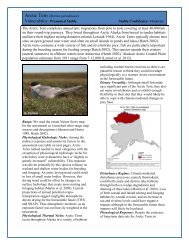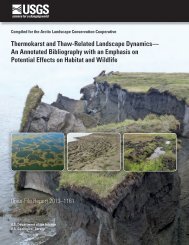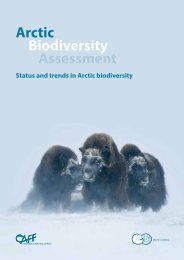Assessing Climate Change Vulnerability of Breeding Birds in Arctic ...
Assessing Climate Change Vulnerability of Breeding Birds in Arctic ...
Assessing Climate Change Vulnerability of Breeding Birds in Arctic ...
You also want an ePaper? Increase the reach of your titles
YUMPU automatically turns print PDFs into web optimized ePapers that Google loves.
thermokarst disturbances, dra<strong>in</strong>age patterns,and subsequent habitat changes arecomplicated and understudied (Mart<strong>in</strong> et al.2009). Efforts are now target<strong>in</strong>g researchtowards improv<strong>in</strong>g our understand<strong>in</strong>g <strong>of</strong>climate change effects on some <strong>of</strong> theseaspects <strong>of</strong> surface hydrology.There was also <strong>in</strong>sufficient <strong>in</strong>formationto address questions about genetics andphenology for most species. Species withlow genetic variation are generally thoughtto be more vulnerable to climate change (seeYoung et al. 2010). However, there is awidely acknowledged paucity <strong>of</strong> studiesdocument<strong>in</strong>g genetic variation other than afew targeted efforts (see species accounts forcitations) and some general assessments at abroader taxonomic level (e.g., Baker andStrauch 1988). Long-term data sets and/orregion-wide data sets relevant to phenologydo exist for some waterfowl (e.g. Larned etal. 2012), shorebirds (R. Lanctot,unpublished data; J. Liebezeit, unpublisheddata,), and other bird groups <strong>in</strong> the <strong>Arctic</strong>LCC region. Some <strong>of</strong> these data are be<strong>in</strong>gused to exam<strong>in</strong>e the relationship betweenremotely sensed variables (e.g., NDVI) andbird arrival and nest <strong>in</strong>itiation (D. Ward etal. unpublished). For the majority <strong>of</strong> birds,however, long-term data are non-existent,<strong>in</strong>adequate for phenology assessments, oravailable but not currently applied toassess<strong>in</strong>g such changes.Limitations <strong>of</strong> the CCVI tool<strong>Climate</strong> change vulnerability <strong>in</strong>dices are oneapproach to understand<strong>in</strong>g the effects <strong>of</strong>climate on species (e.g., Rowland et al.2011). As with all approaches, there arelimitations to the NatureServe CCVI tooland how it is applied. Most importantly, theCCVI tool does not exam<strong>in</strong>e statistical ormechanistic relationships between thespecies traits and their exposure to climatechange. Rather, the tool was designed to<strong>of</strong>fer a relatively coarse, quick, andconsistent look at the potential vulnerability<strong>of</strong> multiple species <strong>in</strong> a way that accountsfor numerous factors. It is structured toreadily add new <strong>in</strong>formation and revise theassessments as knowledge <strong>of</strong> the species andsystem <strong>in</strong>creases and may be used toidentify need for more targeted researchefforts.There are also issues related to themanner <strong>in</strong> which we conducted ourassessment. The CCVI tool was developedto consider a wide range <strong>of</strong> both plant andanimals species <strong>in</strong> an area. Our narrow focuson birds tested its ability to parse out morenuanced differences <strong>in</strong> sensitivities andrelative vulnerabilities between closelyrelated species. As illustrated by themodifications suggested by expertparticipants and documented <strong>in</strong> the Methodssection, the generalized language onsensitivity factors from the CCVI guidancewas sometimes challeng<strong>in</strong>g to relate to birds<strong>in</strong> the <strong>Arctic</strong> and, <strong>in</strong> a few cases, irrelevantaltogether. Although participants did notidentify any miss<strong>in</strong>g sensitivity factors priorto its application, many <strong>of</strong> themrecommended that the differential weight<strong>in</strong>g<strong>of</strong> particular sensitivity factors onvulnerability outcomes be allowed. Forexample, some workshop participantsquestioned whether factors such asdisturbance effects and genetic <strong>in</strong>fluence onclimate change response should carry equalweight. Another challenge, regard<strong>in</strong>g theeffects <strong>of</strong> climate-related changes <strong>in</strong>disturbance regimes, is that changes <strong>in</strong> sometypes <strong>of</strong> disturbance might benefit a specieswhile others might be detrimental, mak<strong>in</strong>gthe net effect difficult to determ<strong>in</strong>e andscore.F<strong>in</strong>ally, many species we exam<strong>in</strong>edrange widely across the world and areexposed to different climate stressors at theirw<strong>in</strong>ter<strong>in</strong>g and stag<strong>in</strong>g areas. We exploredclimate change impacts for the shorebirdsubgroup across their flyways (Appendix C),28








